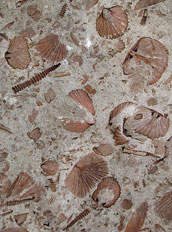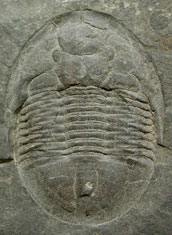After taking up his post at Mason College, Charles Lapworth spent many years studying the geology of the Midlands and surrounding areas.

Shelly fauna from the
Welsh Borders
The geology of the Welsh borders, Shropshire and West Midlands, is rich in Lower Palaeozoic rocks (Cambrian, Ordovician and Silurian), which were deposited on the eastern margin of a sedimentary basin (the Welsh Basin). In Central Wales comparatively deep-water sediments were deposited in the more actively subsiding part of the basin, while to the east shallow water sediments accumulated on a more stable area know as the Midland Platform. Throughout the period sea levels fluctuated within the basin and there were episodes of volcanic activity, and active faulting. Rocks representing a diverse range of sedimentary environments were deposited across the area, many of which are highly fossiliferous.
Lapworth's work involved detailed mapping and interpretation of the geological structures, rock types and associated faunas of the region. Again he used his knowledge of the graptolites and other fossil groups to date, correlate and interpret various rock sequences within the region.

Ordovician trilobite from Shropshire
He worked closely with his colleagues and research students at the University, and other notable geologists studying the area. He also built up strong links and friendships with numerous 'amateur' geologists active in the region, and was always eager to help them in their work, and involve them in his own research. Lapworth was instrumental in important discoveries of Lower Cambrian rocks and fossils at Comley Quarry near Church Stretton in Shropshire, and at Hartshill Quarry near Nuneaton in Warwickshire.
Through this long period of research Lapworth built up a fine collection of fossils from the area with many examples from important, and now classic, geological localities. Lapworth's co-workers and friends also donated considerable amounts of material to the museum.
The collections have continued to grow with the addition of important material from later staff and research workers at the University, and from individuals within the region. Of particular note is the collection of John Wattison (1884-1974) who worked in the pottery industry initially in Stoke, and then Portugal, before moving to Shrewsbury. He was a great amateur collector and the museum has approximately 20,000 of his specimens, including many Lower Palaeozoic fossils from Shropshire and the Welsh Borders, collected during his many field excursions in the region. Wattison's collection has been used by many palaeontologists studying the Lower Palaeozoic fossils of the region, and is particularly rich in trilobites.